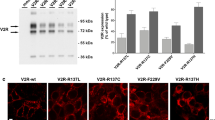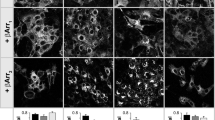Abstract
Membrane receptors that couple to guanine nucleotide binding protein (GPCRs) represent one of the largest families of proteins in the genome. Because of their universal distribution and multiple actions, genetic variations of GPCRs are associated with various human diseases. For instance, the clinical phenotype of congenital nephrogenic diabetes insipidus has been linked to more than 155 loss-of-function putative mutations of the arginine vasopressin (AVP) V2 receptor, which span each and every segment of this seven-transmembrane domain receptor. These mutant receptors, which are mostly trapped in the endoplasmic reticulum, can be rescued by membranepermeant nonpeptidic AVP receptor antagonists. An overexpression of V1-vascular and V3-pituitary AVP receptors has been observed in some endocrine tumors. The single nucleotide polymorphism of AVP receptors in the context of complex genetic traits is currently being investigated, and preliminary findings have been reported in arterial hypertension and autism.
Similar content being viewed by others
References and Recommended Reading
Rana BK, Shiina T, Insel PA: Genetic variations and polymorphisms of G protein-coupled receptors: functional and therapeutic implications. Annu Rev Pharmacol Toxicol 2001, 41:593–624.
Clapham DE: Mutations in G protein-linked receptors: novel insights on disease. Cell 1994, 75:1237–1239.
Simonds WF: G protein-regulated signaling dysfunction in human disease. J Investig Med 2003, 51:194–214.
Thibonnier M, Coles P, Thibonnier A, Shoham M: The basic and clinical pharmacology of nonpeptide vasopressin receptor antagonists. Annu Rev Pharmacol Toxicol 2001, 41:175–202. Comprehensive review of the physiology and pharmacology of vasopressin receptors and their nonpeptide receptor antagonists.
Thibonnier M, Conarty DM, Preston JA, et al.: Molecular pharmacology of human vasopressin receptors. Adv Exp Med Biol 1998, 449:251–276.
Bichet DG, Lonergan M, Arthus MF, et al.: Nephrogenic diabetes insipidus due to mutations in AVPR2 and AQP2. In Neurohypophysis: Recent Progress of Vasopressin and Oxytocin Research. Edited by Saito T, Kurokawa K, Yoshida S. Amsterdam: Elsevier Science; 1995:605–613.
Birnbaumer M: Mutations and diseases of G protein coupled receptors. J Recept Signal Transduct Res 1995, 15:131–160.
Bichet DG, Oksche A, Rosenthal W: Congenital nephrogenic diabetes insipidus. J Am Soc Nephrol 1997, 8:1951–1958.
Oksche A, Rosenthal W: The molecular basis of nephrogenic diabetes insipidus. J Mol Med 1998, 76:326–337.
Morello JP, Bichet DG: Nephrogenic diabetes insipidus. Annu Rev Physiol 2001, 63:607–630. Thorough description of nephrogenic diabetes insipidus and related mutations of the vasopressin receptor.
Barak LS, Oakley RH, Laporte SA, Caron MG: Constitutive arrestin-mediated desensitization of a human vasopressin receptor mutant associated with nephrogenic diabetes insipidus. Proc Natl Acad Sci U S A 2001, 98:93–98.
Wilbanks AM, Laporte SA, Bohn LM, et al.: Apparent lossof-function mutant GPCRs revealed as constitutively desensitized receptors. Biochemistry 2002, 41:11981–11989.
Morello JP, Salahpour A, Laperrière A, et al.: Pharmacological chaperones rescue cell-surface expression and function of misfolded V2 vasopressin receptor mutants. J Clin Invest 2000, 105:887–895. Seminal work demonstrating the rescue of misfolded vasopressin receptors by cell-permeant nonpeptide antagonists.
Tan CM, Nickols HH, Limbird LE: Appropriate polarization following pharmacological rescue of V2 vasopressin receptors encoded by X-linked nephrogenic diabetes insipidus alleles involves a conformation of the receptor that also attains mature glycosylation. J Biol Chem 2003, 278:35678–35686.
Wersinger SR, Ginns EI, O’Carroll AM, et al.: Vasopressin V1b receptor knockout reduces aggressive behavior in male mice. Mol Psychiatry 2002, 7:975–984.
Arnaldi G, Gasc J, de Clauser E, Bertagna X: Variable expression of the V1 vasopressin receptor modulates the phenotypic response of steroid-secreting adrenocortical tumors. J Endocrinol Metab 1998, 83:2029–2035.
Mune T, Murase H, Yamakita N, et al.: Eutopic overexpression of vasopressin V1a receptor in adrenocorticotropinindependent macronodular adrenal hyperplasia. J Clin Endocrinol Metab 2002, 87:5706–5713. Example of overexpression of vasopressin receptors in endocrine tumors.
De Keyser Y, Lenne F, Auzan C, et al.: The pituitary V3 vasopressin receptor and the corticotroph phenotype in ectopic ACTH syndrome. J Clin Invest 1996, 97:1311–1318.
Dahia PL, Ahmed-Shuaib A, Jacobs RA, et al.: Vasopressin receptor expression and mutation analysis in corticotropinsecreting tumors. J Clin Endocrinol Metab 1996, 81:1768–1771.
Rene P, Grino M, Viollet C, et al.: Overexpression of the V3 vasopressin receptor in transgenic mice corticotropes leads to increased basal corticosterone. J Neuroendocrinol 2002, 14:737–744. Example of overexpression of vasopressin receptors in endocrine tumors.
Small KM, Tanguay DA, Nandabalan K, et al.: Gene and protein domain-specific patterns of genetic variability within the Gprotein coupled receptor superfamily. Am J Pharmacogenomics 2003, 3:65–71.
Thibonnier M, Jeunemaitre X, Graves MK, et al.: Structure of the human V1a vasopressin receptor gene. In Neurohypophysis: Recent Progress of Vasopressin and Oxytocin Research. Edited by Saito T, Kurokawa T, Yoshida S. Amsterdam: Elsevier Science; 1995:553–571.
Thibonnier M, Graves MK, Wagner MS, et al.: Study of V(1)-vascular vasopressin receptor gene microsatellite polymorphisms in human essential hypertension. J Mol Cell Cardiol 2000, 32:557–564. Role of vasopressin receptor polymorphism in a complex trait.
Kim SJ, Young LJ, Gonen D, et al.: Transmission disequilibrium testing of arginine vasopressin receptor 1A (AVPR1A) polymorphisms in autism. Mol Psychiatry 2002, 7:503–507.
Chen CH, Chen WY, Liu HL, et al.: Identification of mutations in the arginine vasopressin receptor 2 gene causing nephrogenic diabetes insipidus in Chinese patients. J Hum Genet 2002, 47:66–73.
Author information
Authors and Affiliations
Rights and permissions
About this article
Cite this article
Thibonnier, M. Genetics of vasopressin receptors. Current Science Inc 6, 21–26 (2004). https://doi.org/10.1007/s11906-004-0006-8
Issue Date:
DOI: https://doi.org/10.1007/s11906-004-0006-8




